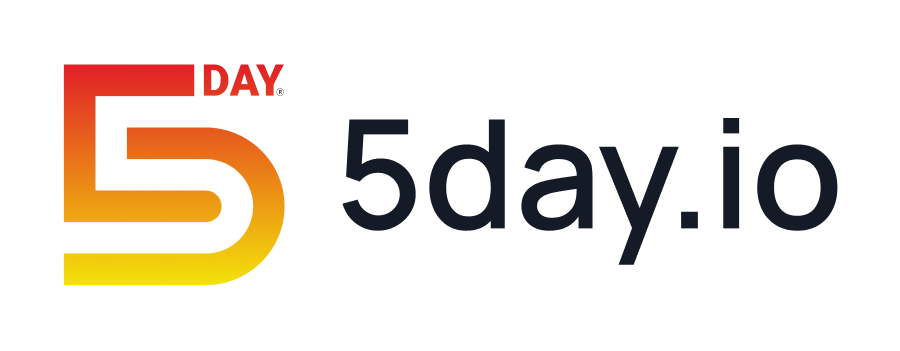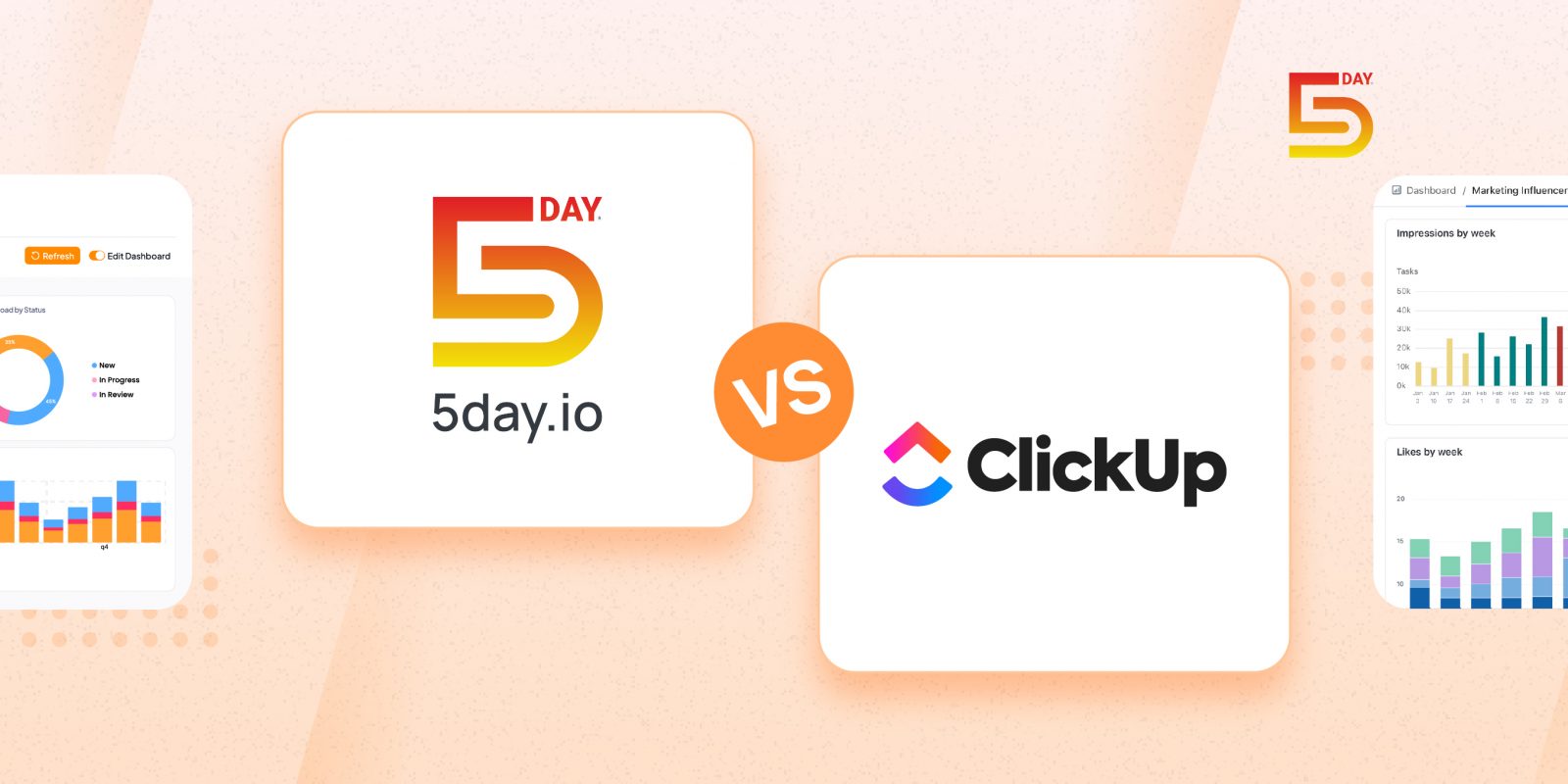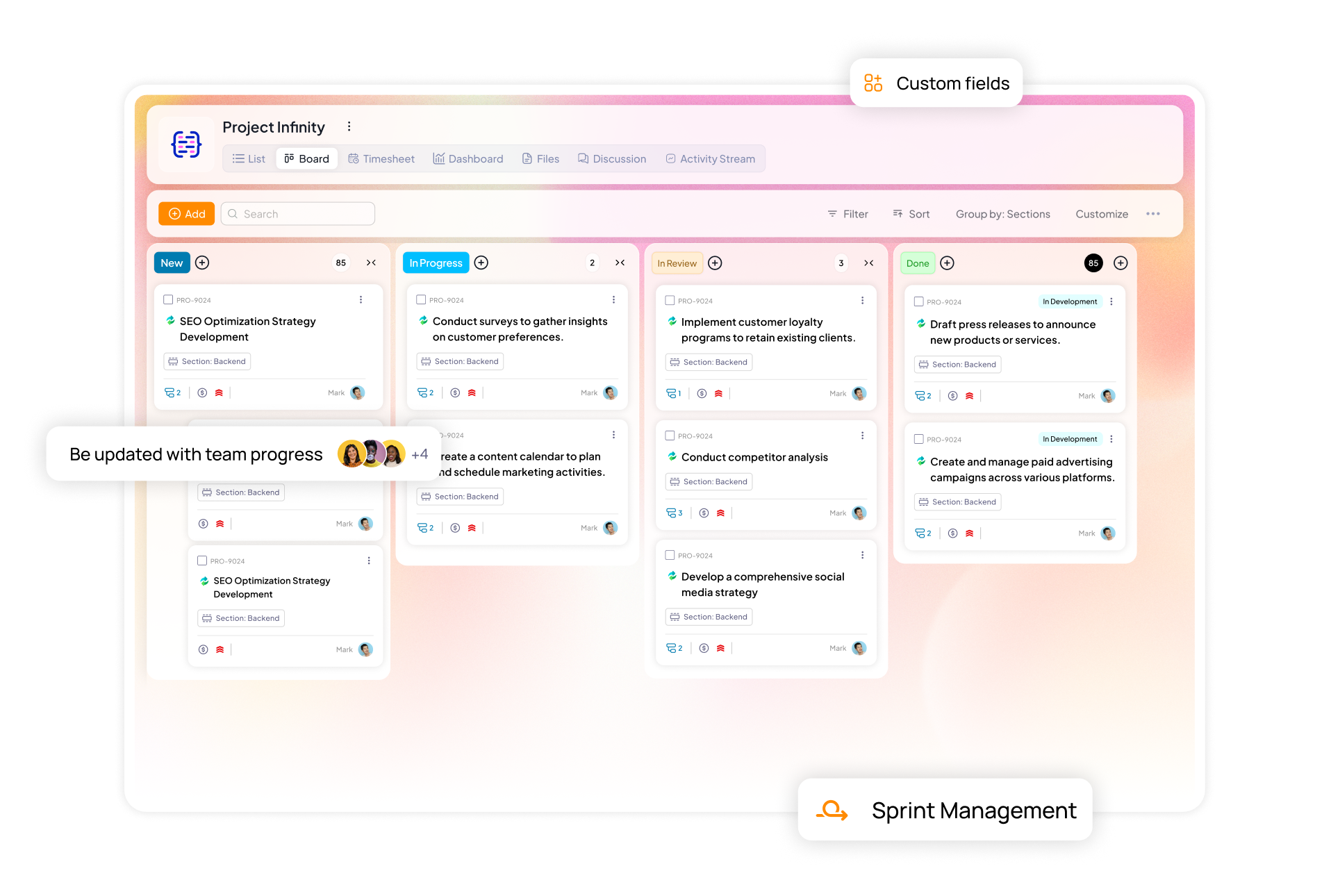Content calendars often look like simple scheduling tools, but the real value lies in the data they generate. Every met deadline, every delay, and every project milestone becomes a data point that can sharpen your strategy.
Effective content calendar management helps you build an intelligence layer that reveals how your team works best. It aligns blog posts, social media, emails, and campaigns with deadlines and goals.
With the right approach, your team can visualize every upcoming post, assign owners, and hit every deadline. In this guide, you’ll learn how to design and manage a calendar that doubles as both a planning framework and a performance dashboard for your marketing.
What is a content calendar? (And why your team shouldn’t work without one)
A content calendar is essentially a visual roadmap for your marketing content. It lists every planned piece of content, like blogs, social posts, emails, etc., their publishing dates, and associated details.
In other words, it’s how you organize and schedule all your content, ideally, for a calendar month.
But effective editorial calendars go beyond simple date sheets. They include campaign context, briefs, channels, and ownership, so every team member knows what to create and when.
It acts as a strategic engine that maps every deliverable to its campaign. By integrating the calendar with project tasks, you can instantly see what’s done, what’s live, what’s late, and who’s responsible.
So, what to include in a content calendar? At a minimum, cover content type, publish date, channel, campaign context, and owner.
And, why shouldn’t teams live without one? Without a unified calendar, even experienced marketing teams feel disconnected. With so many types of content moving in parallel, it becomes easy to miss deadlines or overlook dependencies.
Poor communication and lack of visibility often stall projects, as none of the team members have a clear bird’s-eye view of the content pipeline. An effective content calendar solves these problems. It brings all content planning into one place, so teams stay on the same page.
What is content calendar management?
Content calendar management is the practice of designing and optimizing your content calendar as part of your workflow. It means treating the calendar as a living document by continually assigning owners, setting deadlines, tracking, and adjusting timelines when priorities change.
For example, if a product launch date shifts, a well-managed content calendar updates all related tasks and posts. Further, it alerts everyone responsible and reorganizes priorities. As a result. your team gains clarity on what to tackle first, who owns what, and how deadlines adjust.
In short, content calendar management ensures accountability and flexibility. This clear structure keeps everyone aligned and aware of the next steps.
Benefits of effective content calendar management
Solid content calendar management brings many benefits to marketing teams. These include:
1. Improved organization and planning
A content calendar provides a single view of all upcoming content, like topics, formats, and publish dates. All this helps maintain a structured approach. It also ensures you cover all themes relevant to your audience and spot gaps early.
2. Consistency and predictability
When you schedule content in advance, your team can build a steady publishing rhythm. This consistency helps gain audience trust and makes your team feel more stable and dependable instead of ad hoc.
3. Better time management
Planning content ahead allows you to allocate tasks with realistic deadlines. This structure ensures your team has enough time to create quality content without rushing or sacrificing content quality
4. Enhanced collaboration and accountability
A shared calendar means everyone, from writers, designers, to strategists, can see the plan. This transparency prevents miscommunication and overlaps. Team members know who is responsible for each piece.
It simplifies collaboration and keeps teams in the loop. Calendar tools centralize comments, handoffs, feedback, and status updates, so teams don’t lose them in email or chat.
5. Adaptability to trends and events
A digital calendar makes it easier to pivot. If a big news event or trend emerges, you can quickly insert or adjust content. With an editable calendar, teams can identify gaps and opportunities and stay relevant.
As a result, you can push or reschedule posts in minutes when priorities change. A social media content calendar makes it even easier to adjust quickly when trends emerge or priorities shift.
6. Visibility into process performance
A calendar helps track the whole content process. By tracking stages (idea, draft, review, publish), you surface bottlenecks and inefficiencies. Teams gain a bird’s eye view of all content, which makes it easier to analyze progress.
Selecting the right tools for content calendar management
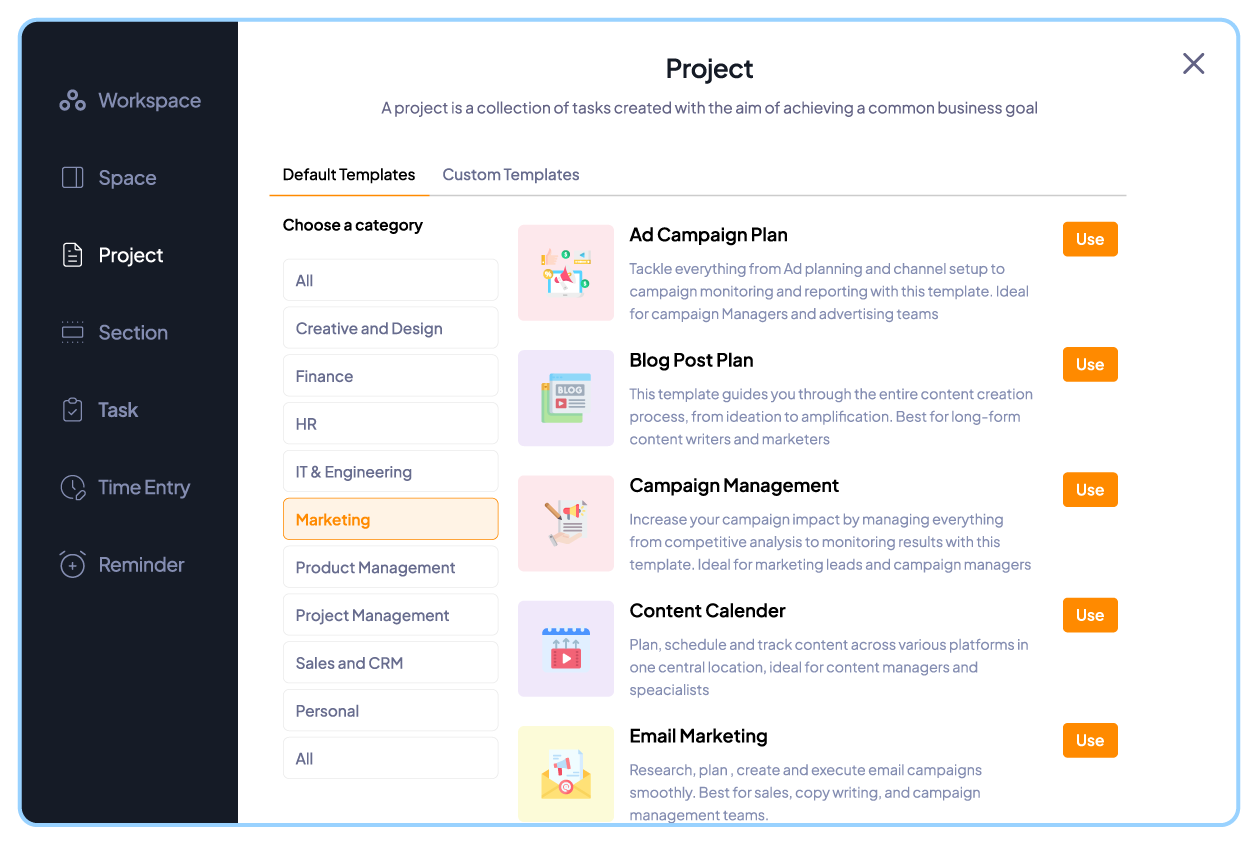
Choosing the right tool is critical for content calendar management. At the simplest level, some teams use spreadsheets or Google Calendar. But spreadsheets and basic calendars have serious limitations for content planning.
They lack automated reminders, real-time collaboration, and the ability to handle dependencies. Calendars like Google or Outlook offer visualization but no integration with your project tasks or assets.
Project management software like 5day.io for marketing solves these gaps. It offers content calendar view that integrates directly into the workflow. When content and tasks live in the same system, you can see the full picture.
When selecting a tool, look for marketing-specific features, like:
1. Automation and alerts
Good platforms auto-notify responsible users about upcoming deadlines and status changes. Unlike spreadsheets, they can send reminders and automatically move tasks when something is completed. This cuts down on manual follow-ups.
2. Built-in templates
For recurring processes (like a blog or campaign workflow), many tools, including 5day.io, provide customizable templates. Rather than building a new board each time, you can use a template that pre-defines tasks. It helps save setup time, ensuring your team doesn’t miss any steps.
3. Collaboration features
Comments, tags, assets, and feedback should live natively in the tool. 5day.io, for example, includes built-in threaded comments directly on tasks. This means no more hunting through email, as all discussions stay with the work in one place.
4. Approval workflows
The best systems let you automate multi-stage approvals. You can assign reviewers, set deadlines, and track who has signed off.
For example, social media calendars help establish clear communication and align everyone on the plan, which optimizes approval workflows by making steps visible.
Advanced techniques for content calendar management
Once you have a calendar in place, focus on techniques that make it work for you. Here are advanced tips on how to manage a content calendar:
1. Treat it as a living document
Your content calendar should be regularly reviewed and updated. Marketing needs change, so build time to revisit and revise the plan.
For example, set a weekly review to adjust any shifted dates or add new tasks. Regularly review and update the calendar with the changing strategy. Keep the calendar active and current so your team continues to use it as a single source of truth.
2. Set reminders and milestones
Use your project management software’s notification system to keep owners on track. Schedule alerts for key milestones (like draft due, review due, publish date). 5day.io, for instance, can auto-notify team members when a task stage changes.
Also, define major campaign milestones (product launches, events) on the calendar so all content ties to those dates.
3. Define playbooks and templates
Standardize routine projects. If your team often creates blog posts or social campaigns, create a template (or playbook) for each. This might include a checklist or list of tasks that are non-negotiable (brief, draft, edit, approvals, publish, promote).
In practice, 5day.io’s custom templates feature lets you save and reuse entire project structures, ensuring consistency and saving setup time.
4. Use tagging and filtering
Categorize content by topic, campaign, format, or priority. Tags and custom fields allow you to filter the calendar for specific views.
For example, tag all holiday content together, or use colored labels for blog vs social. This helps spot overload and balance resources.
5. Lock in approvals on schedule
Integrate the review process into the calendar. Schedule the approval steps (legal review, client sign-off) as separate tasks or stages. That way, no one can publish content until someone completes the approval task.
This prevents last-minute holdups. Having a calendar with a visual plan provides simultaneous visibility among contributors and stakeholders.
6. Monitor and iterate
After publishing, use metrics to feed back into planning. Track what content performed well and update your calendar priorities accordingly. Best practices include analyzing page views, engagement, or lead metrics and then adjusting topics or cadence.
If certain content underperforms, replace or repurpose it. The calendar itself should evolve based on real-world feedback.
7. Collaborate with transparency
Encourage team members to update the calendar with status notes or comments as they work. A shared calendar keeps everyone accountable. For example, if a writer finishes a draft, they should update the task to ‘Ready for Review.’ This transparency cuts down on one-off messages.
8. Maintain a backlog
Don’t forget to include future ideas. Keep a section of your calendar (or a connected backlog) for content ideas that aren’t scheduled yet.
Then, slot them in when time opens up. This ensures you always have content to fill gaps and can quickly adapt if a planned piece falls through. Keeping a backlog also gives you a set of content calendar examples you can draw from when you need quick wins.
9. Balance short-term and long-term planning
Use views to switch between a detailed task view and a high-level roadmap. 5day.io, for instance, has ‘My Work’ and campaign views that let individuals see daily tasks, while managers see quarterly roadmaps.
This dual focus (immediate deadlines and big-picture strategy) is a helpful practice in content planning.
How 5day.io helps implement your content calendar strategically
Putting it all together, here’s a step-by-step approach to rolling out a content calendar and how 5day.io supports each step:
1. Set clear goals and themes
The first step in how to create a content calendar is to set clear goals and themes that connect directly to your campaigns.
Start by defining what you want to achieve (brand awareness, leads, etc.) and identifying your audience and key content themes. For example, break content into categories like
- Thought leadership
- Product education
- Promotional content
This strategic context guides how you build and use the calendar.
Use custom tags or fields to label each content piece by campaign or goal, so reporting can later tie outputs to objectives.
2. Audit and inventory
Review existing content for topics that have been covered. Figure out which topics performed well, and where gaps exist.
Then, compile a backlog of content ideas from stakeholders. Your content audit tells you what to schedule first.
Use 5day.io to create a log for content ideas. You can enter each idea as a card (task), keeping them organized for later planning.
3. Assign roles
Clearly define who will do each part of the process. Identify your content creators, editors, designers, and approvers.
Set up your calendar workflow to reflect these roles. Add team members as task owners with custom permissions based on their role in the project.
5day.io allows assigning multiple people to a content card (such as a writer and an editor on the same card).Everyone knows their responsibilities along with all the relevant information related to the given task.
4. Choose and set up your view
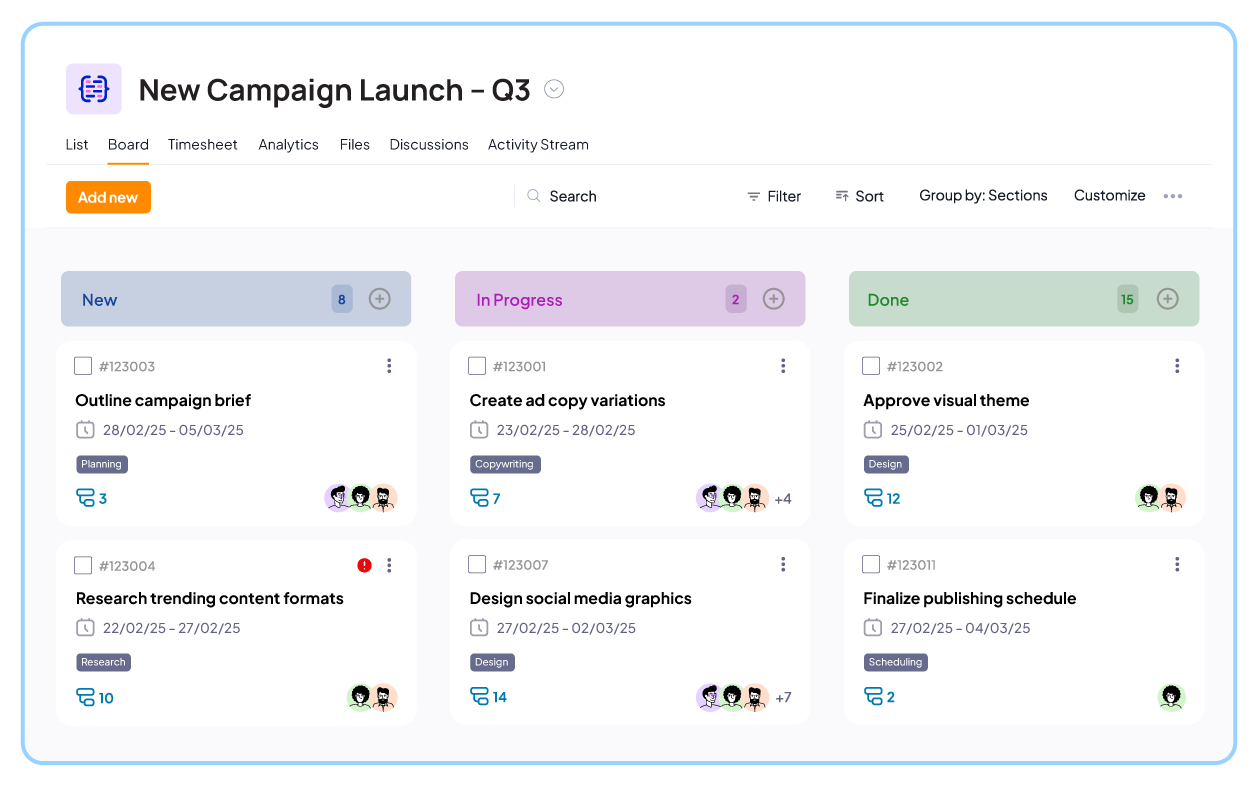
Decide on the view that fits your needs. Then build out the basic calendar structure. For example, create a project or board named ‘editorial calendar, and set up columns or dates.
Use a Board view for your editorial calendar.
5day.io’s board (Kanban) lets you drag cards across stages. You can also view the same content on a calendar or timeline. With different views, you harness the flexibility of an editorial calendar with a board view to adapt to shifting content needs.
If you’re wondering how to set up an editorial calendar in SaaS platforms, 5day.io makes it simple with multiple views, connecting to the same workflow.
5. Model your content workflow
Within the calendar, define the steps each piece goes through (ideation → drafting → reviewing → publishing). In 5day.io, you can represent these as stages that shows everyone where each piece of content stands in the workflow.
6. Kick off with templates
Use or create templates for recurring content types. Instead of starting from scratch each time, build or customize a pre-built template for a blog post, newsletter, email, and social campaign that automatically creates the necessary tasks and project stages.
5day.io allows you to build a template once and reuse it forever. When you pre-define structures for common content types, every new campaign follows best-practice steps and gets set up faster.
7. Populate the calendar
Start filling in actual content. You can add titles, assign owners, and set publish dates for each piece. Include all channels on the same calendar to avoid siloes.
Visualize content by day, week, or campaign to enable team members to see exactly what’s on deck. You can link deadlines and dependencies automatically.
For example, if you create a task for a blog post in 5day.io, its due date shows up on the calendar and on the assignees’ personal ‘My Work’ list.
8. Review and optimize
Among the most important content calendar best practices is tying your publishing rhythm back to real performance data.
Once live, regularly revisit your calendar. Hold planning meetings around it. Track performance metrics for each piece and adjust future entries accordingly.
Remove completed items and reschedule or rewrite underperforming ones.
You can use real-time dashboards to monitor progress. 5day.io offers dashboards to find where delays occur and ensure compliance with deadlines. These analytics help managers make data-driven adjustments and allocate more resources to a bottleneck content type.
Transform how you plan your marketing content calendar with 5day.io
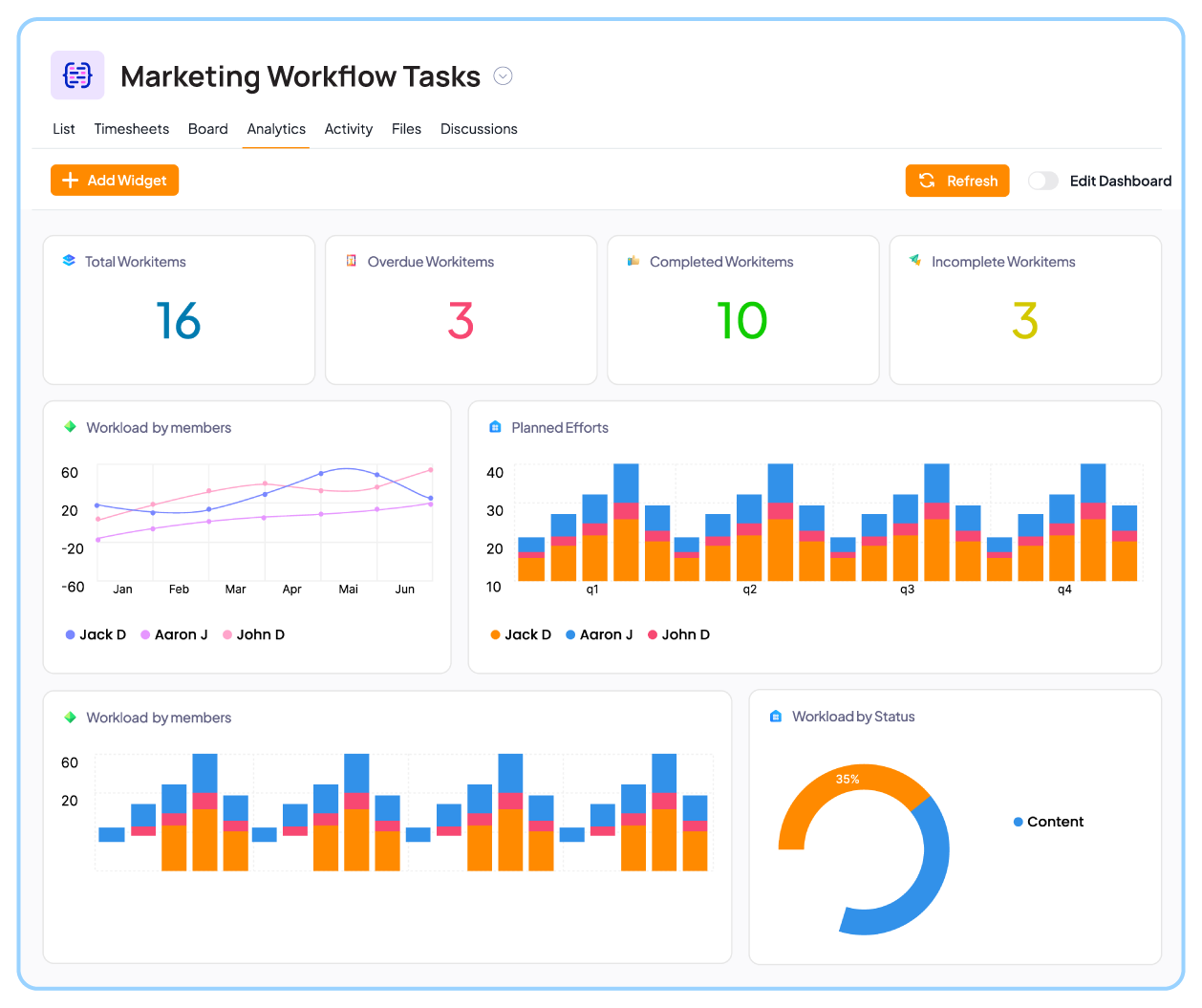
Content calendar management brings structure to creativity and gives your team the confidence to deliver on every campaign. It evolves into a framework that not only organizes tasks but also provides insights into how your marketing efforts perform over time.
With 5day.io, your team goes beyond scheduling.
- You can centralize every campaign in one place, assign clear owners, and track progress in real time
- Built-in templates eliminate repetitive setup work
- Automation takes care of reminders, clear handoffs, feedback, and approvals
- Multiple views let each team member see work the way they need
- Shared dashboards improve transparency for everyone involved
The result is content calendar management that adapts as quickly as your strategy, reducing the clutter of scattered tools. It means your team spends more time creating instead of coordinating.
If you want your calendar to fuel clarity and consistent results, now is the time to act.
Start free with 5day.io today for 30 days and give your team the clarity they deserve.
Frequently Asked Questions
1. How often should I update the content calendar?
Update your content calendar continuously. Check it weekly (or even daily) to reflect progress. Whenever a piece moves to a new stage (draft complete, review done, etc.), update its status.
Also, revise the calendar monthly or quarterly as strategy changes. Regular updates ensure alignment with goals, so ensure that it aligns with your marketing goals.
2. What are content calendar management best practices?
The content calendar best practices include keeping the calendar centralized and accessible to all team members. Use templates for recurring workflows, automate reminders and dependencies, and review performance data regularly to refine the schedule.
Involve the entire team in planning sessions and gather input, such as content ideas and feedback from stakeholders. Apply color-coding or tags for different content types and lock in approvals directly within the calendar to keep workflows smooth and transparent.
3. What is the difference between an editorial calendar and a content calendar?
Teams often use the terms interchangeably. An editorial calendar originated in publishing and highlights what content to publish and when, typically for blogs or magazines.
A content calendar covers a broader scope that includes social media, emails, and multi-channel campaigns.
In practice, both tools organize content planning. Some teams use an editorial calendar to emphasize storytelling and planning. On the other hand, teams use a content calendar to include all formats such as blogs, social media, and ads.
